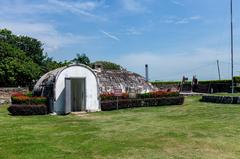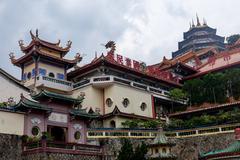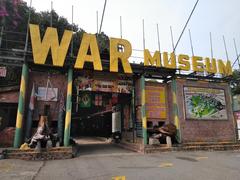
Kong Hock Keong Temple: Visiting Hours, Tickets, and Historical Significance in Penang, Malaysia
Date: 04/07/2025
Introduction
Kong Hock Keong Temple, also known as the Goddess of Mercy Temple or Kuan Yin Teng, stands as one of Penang’s most significant and oldest Chinese temples. Located in the heart of George Town, the temple is not only a center of spiritual devotion but also a focal point for the cultural and communal life of Penang’s Chinese community. With a history dating back to 1800, Kong Hock Keong offers visitors a unique opportunity to experience Penang’s rich heritage, stunning architecture, and vibrant religious festivals. This guide provides comprehensive information on visiting hours, tickets, accessibility, history, and practical tips for making the most of your visit.
Table of Contents
- Historical Background
- Visitor Information
- Rituals, Festivals, and Devotional Practices
- Cultural Etiquette and Visitor Tips
- Conservation and Heritage Management
- Nearby Attractions
- Frequently Asked Questions (FAQ)
- Conclusion
- References
Historical Background
Origins and Evolution
Kong Hock Keong Temple was established in 1800 on land granted by the East India Company. Built by Penang’s early Hokkien and Cantonese communities, its design was inspired by Malacca’s Cheng Hoon Teng Temple, reflecting the spiritual and communal needs of Chinese settlers (xiao-en.org). Originally dedicated to Ma Chor Po (Mazu), the patron saint of seafarers, the temple evolved to primarily venerate Guanyin (the Goddess of Mercy) as the community’s needs changed.
Religious and Social Roles
The temple is a key Mahayana Buddhist site, with Guanyin as its principal deity. Devotees seek blessings for healing, protection, and compassion. In addition, the temple houses altars to Ma Chor Po and other Taoist deities, reflecting the syncretic religious practices of Penang’s Chinese diaspora (fooeyscultureblog.wordpress.com). Beyond spiritual functions, Kong Hock Keong historically served as a community arbitration center, mediating disputes and fostering unity among various Chinese clans.
Architectural Highlights
Kong Hock Keong Temple is a fine example of southern Chinese temple architecture. The east-west orientation, sweeping tiled roofs, ornate dou gong brackets, and elaborately carved granite lions (donated in 1829) showcase the artistry and craftsmanship of early Chinese settlers (xiao-en.org). The temple’s walls and pillars are adorned with historical murals, calligraphic plaques, and ceramic figurines depicting mythological scenes, reflecting both Buddhist and Taoist influences.
Community Influence and Resilience
Throughout its history, the temple has played a pivotal role during social upheavals, including mediating between secret societies in the 19th century and surviving wartime threats during the Japanese Occupation. Its resilience is further demonstrated by its survival of fires and bombings, and its continued restoration and conservation efforts (fooeyscultureblog.wordpress.com).
Visitor Information
Location and Accessibility
- Address: 5, Lorong Stewart, George Town, 10200 Pulau Pinang, Malaysia.
- Getting There: The temple is centrally located on Jalan Masjid Kapitan Keling, within George Town’s UNESCO World Heritage core. It is easily accessible by foot, public transport, and taxi. The free MPPP CAT tour bus (Stop No. 16) and city buses (101, 104, 201, 206) serve the temple, making it convenient for visitors from major transit points like the Penang Ferry Terminal and Komtar.
Opening Hours
- Daily: 8:00 AM – 6:00 PM (core visiting hours may vary slightly; early morning visits offer a quieter experience).
Admission and Tickets
- Entry: Free of charge. Donations are welcome to support temple maintenance and community programs.
Guided Tours and Special Events
- Guided Tours: Available through local operators or the Penang Heritage Trust. Advance booking is recommended.
- Festivals: Major religious events, such as the birthdays of Guanyin (19th day of the 2nd, 6th, and 9th lunar months), the Jade Emperor’s Birthday, and the Hungry Ghost Festival in August, are celebrated with rituals, lion dances, and Chinese opera performances.
Photography Tips
- Allowed: Photography is permitted in most areas, but visitors should avoid using flash and be respectful during worship or ceremonies.
Rituals, Festivals, and Devotional Practices
Devotees and visitors participate in lighting incense, offering fruits and flowers, and bowing at the main altar. Fortune stick (kau cim) consultation is a popular activity, and visitors are welcome to observe or join in rituals, especially during major festivals. The temple’s ambiance is enhanced by the glow of candles, the scent of incense, and the sound of chanting, creating a spiritually uplifting environment.
Cultural Etiquette and Visitor Tips
- Dress modestly; shoulders and knees should be covered.
- Remove hats and shoes before entering prayer halls.
- Speak softly and avoid obstructing worshippers.
- Non-Buddhists are welcome to observe or participate in rituals respectfully.
- Offerings such as incense, candles, and flowers can be purchased outside the temple.
- Consider the ethical implications before participating in the traditional practice of releasing birds.
- Some areas have steps or uneven flooring; the main entrance is wheelchair accessible.
Conservation and Heritage Management
Kong Hock Keong Temple is recognized as a heritage site within the George Town UNESCO World Heritage listing. Recent renovations (2012–2017) have preserved its original features, and ongoing conservation focuses on safeguarding both its tangible architecture and intangible cultural practices.
Nearby Attractions
Kong Hock Keong Temple’s central location makes it an excellent starting point for exploring George Town’s historical and cultural landmarks, including:
- Kapitan Keling Mosque: A symbol of Penang’s multicultural harmony.
- Penang Peranakan Mansion: Museum of Straits Chinese culture.
- Penang Chinese Town Hall: Important heritage building.
- George Town’s Street Art: Renowned murals and installations.
Nearby, visitors will also find cafes, food stalls, and souvenir shops, offering a taste of Penang’s vibrant street life.
Frequently Asked Questions (FAQ)
Q: What are the visiting hours of Kong Hock Keong Temple?
A: Daily, 8:00 AM – 6:00 PM.
Q: Is there an entrance fee or tickets required?
A: No, admission is free; donations are appreciated.
Q: Are guided tours available?
A: Yes, through local tour operators or the Penang Heritage Trust; book in advance.
Q: Is the temple wheelchair accessible?
A: The main entrance has ramps, though some older sections may have limited access.
Q: What is the best time to visit?
A: Early mornings or weekdays for a quieter experience; major festivals for cultural immersion.
Q: Can I take photographs inside the temple?
A: Yes, but be respectful and avoid flash during rituals.
Q: How do I get to the temple from major hubs?
A: The temple is within walking distance from George Town’s core; public buses and the free CAT shuttle also serve the area.
Conclusion
Kong Hock Keong Temple is a living testament to Penang’s multicultural heritage, architectural splendor, and spiritual depth. Whether you are a history enthusiast, spiritual seeker, or cultural explorer, a visit to this temple offers a unique insight into Penang’s past and present. Plan your visit around the temple’s opening hours, enjoy free admission, and immerse yourself in the vibrant community life and nearby historical sites. For a richer experience, consider joining a guided tour and participating in the temple’s colorful festivals.
Ready to explore more?
Download the Audiala app for curated travel guides, insider tips, and exclusive content about Penang’s cultural treasures. Follow us on social media for updates on travel news and cultural events.
References
- Kong Hock Keong Temple Historical and Architectural Overview, 2021, Xiao-en Organization (xiao-en.org)
- Penang’s Goddess of Mercy Temple (Kuan Yin Teng), 2021, Fooey’s Culture Blog (fooeyscultureblog.wordpress.com)
- Sightseeing at Penang: Kuan Yin Teng Temple, 2023, Sightseeing at Penang (Sightseeing at Penang)





















